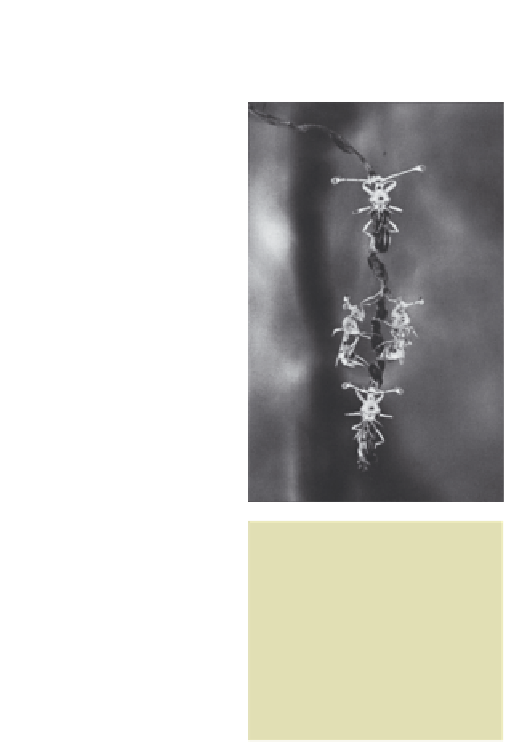Biology Reference
In-Depth Information
where the eye span can exceed their body length
(Fig. 7.10). Along stream banks in peninsular Malaysia,
they roosted on plant roots and males with the largest eye
spans were accompanied by more females. In laboratory
choices it was clear that females preferred males with the
largest eye spans. Wilkinson and Reillo then conducted
artificial selection experiments: in one line they selected
for males with the longest eye spans and in the other for
males with the shortest. After 13 generations they found
that female choice had changed too, as a correlated
response: in the long eye span male line females preferred
long eye span males, while in the short eye span line they
preferred males with short eye spans.
In the streams of Trinidad and north eastern
Venezuela, there is considerable variation in the
colouration of male guppies. In streams with high
predation pressure, the males tend to be dull whereas in
streams with few predators they are brightly coloured,
with large orange spots (Chapter 4). Houde and Endler
(1990) found that there was a correlation between the
amount of orange in males in a population and the
strength of female preference for orange. Sticklebacks,
too, vary between populations in the brightness of the
male's red nuptial colouration. Females prefer redder
males (Milinski & Bakker, 1990) and breeding
experiments revealed that a son's intensity of red was
correlated with that of his father. Furthermore, daughters of red males preferred red
males while daughters of dull males showed no preference for red (Bakker, 1993). Once
again, therefore, there was a positive genetic correlation between trait and preference.
These results suggest there is the potential for Fisher's runaway process (Box 7.3)
but they do not test the key assumption of Fisher's hypothesis, namely that the only
benefit of the selected male trait is increased mating success. To show this, it would be
necessary to show also that the expression of the male trait did not correlate with any
inherited 'utilitarian' aspect of fitness, such as disease resistance or ability to gather
scarce resources, as proposed by the handicap hypothesis. Two ways to examine this
prediction would be: (i) to see whether or not, within a population of males, more
extreme expression of the trait was correlated with viability, and (ii) to examine the
offspring of males with extreme traits. According to Fisher's hypothesis they should
have no enhanced viability, only enhanced male mating success. The difficulty with
both of these tests is that in order to support Fisher's hypothesis one would need to see
a negative result. Negative results could arise for many reasons, including not having
a large enough sample or not measuring the appropriate variables. Furthermore,
Fisher's hypothesis and the good genes hypothesis are not necessarily incompatible
(Iwasa
et al
., 1991). Given a genetic correlation between preference and trait, Fisher's
runaway process has the potential to operate even if the trait is an honest signal of
male genetic quality. We now turn to two case studies that have tested the 'good
genes' hypothesis.
Fig. 7.10
A male (top)
and a group of three
female stalk-eyed flies
roosting on a root hair.
Note the much greater
eye span of the male.
From Wilkinson and
Reillo (1994).
... in guppies
… and in
sticklebacks





























